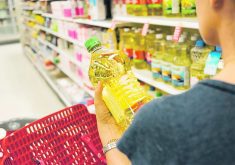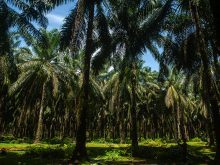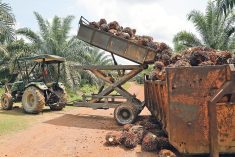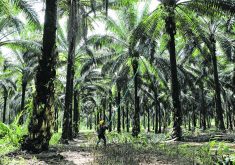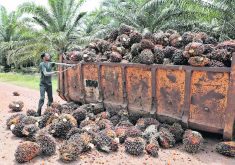Lab-grown food has many hurdles to overcome and the greatest of them might be getting consumer acceptance.
People might pack their shopping carts with all sorts of processed foods loaded up with sugar, fat and hard-to-pronounce ingredients, but lab-grown food is a step too far for many.
But what about a lab-grown ingredient that replaces a plant-produced ingredient in a cosmetic or shampoo? Would consumers warm to that, especially if the marketing for the lab-gown ingredient says that by purchasing it you can save tropical rain forests?
Read Also

Canola used in only quarter of Canadian biofuel
Less than one-quarter of the biodiesel and renewable diesel used in Canada in 2024 was made from canola oil feedstock
That is the argument advanced by a handful of start-up companies in the fledging field of what is sometimes called microbial oil, which is vegetable oil made by fermentation with specialized yeast.
The technology should be able to produce products similar to any type of vegetable oil, including canola and soybean.
But for now the target is palm oil, the world’s most consumed vegetable oil. It is found in many things, from cooking oil and margarine, to candy and chocolate bars, to shampoo and lipstick. It is also processed into renewable diesel.
Overall, 68 percent of the palm oil produced is used in food, 27 percent in industrial and consumer products such as cosmetics and five percent in fuel.
About 79.3 million tonnes of palm oil are produced annually, mostly in Indonesia and Malaysia. That compares to 62.3 million tonnes of soybean oil and 32.9 million tonnes of canola/rapeseed oil.
Palm oil’s attributes are highly prized, it has many uses and it is cheap. Other oils are more expensive and must undergo costly processing to achieve the attributes of palm.
Many products in your home have palm oil ingredients, even though it might not be obvious. Palm might be the source of ingredients such as sodium lauryl sulfate, glycerin and stearic acid.
But palm oil carries a negative environmental footprint.
It is an important driver in deforestation and peat land destruction in tropical countries where it is grown and for that reason has been the target of environmental campaigns to limit its use or at least be certified as being produced in a “forest friendly” system.
The makers of microbial oil are piggybacking their marketing onto the existing concerns about palm oil’s impact on the environment.
One of the microbial oil companies, C16 Biosciences, has lately been able to generate positive press coverage with headlines such as The New Oil that Saves Trees, A Crucial Tool in Combating Climate Change and C16 Biosciences has a Plan to Save Those Rainforests.
The start-up firm, located in New York City, has launched a product called Palmless Torula oil. It marketed a small quantity itself, but its goal is to supply the oil as an ingredient to large cosmetic or personal-care manufacturers.
C16 Biosciences is not alone in developing microbial oils.
Xylome, a company in Wisconsin, has engineered yeast types to produce drop-in replacements for refined, bleached and deodorized palm oil.
Clean Food Group in the United Kingdom and No Palm Ingredients, a Dutch startup, further polish their environmental reputation by addressing the food-waste problem. They take rejected vegetables or any food waste that contains sugar, organic acids or alcohol and use it to feed the yeast. The yeast fills with lipids that are extracted to make the oil. The leftover biomass has protein and nutrients and can be used in animal feed.
The proponents also say that microbial oil fits with the movement advocating local food and manufacturing. It can be produced anywhere that has sugar, organic acids or alcohol to feed the yeast in bioreactors, eliminating the long distance supply chain that moves palm from Indonesia and Malaysia to users around the world.
Of course, these are start-up companies that have proven the technology in small batches. They are just now fundraising to build industrial scale plants. They expect that by scaling up production, the cost of what is now an expensive novelty will fall sharply to become competitive with palm oil. But that might prove overly optimistic and will depend on whether the specialized yeast works at the scale needed.
The products will also have to go through consumer protection and food safety regulatory processes. As well, they will also have to prove to consumers, likely through traceability systems and lifecycle greenhouse gas studies, that the ingredient supply chain and energy use is as “green” as they claim.
The existing palm industry and the governments of Indonesia and Malaysia will not stand by idly. These relatively poor countries in the global south will argue the importance of palm production to their economies, providing work and helping lift millions out of poverty.
They will likely negatively portray microbial oil makers as rich tech “bros” eliminating the livelihoods of poor farmers in developing countries.
Who knows how it will all play out? Microbial oil and the wider movement to use precision fermentation to make a host of products that mimic those produced by traditional agriculture are in their infancy. In some ways they are a threat to traditional agriculture, but in other ways they might help solve serious environmental issues.
No matter what, the technology has advanced to the point where it is attracting serious investment and so it is important to keep abreast of developments to be prepared for what the future holds.





